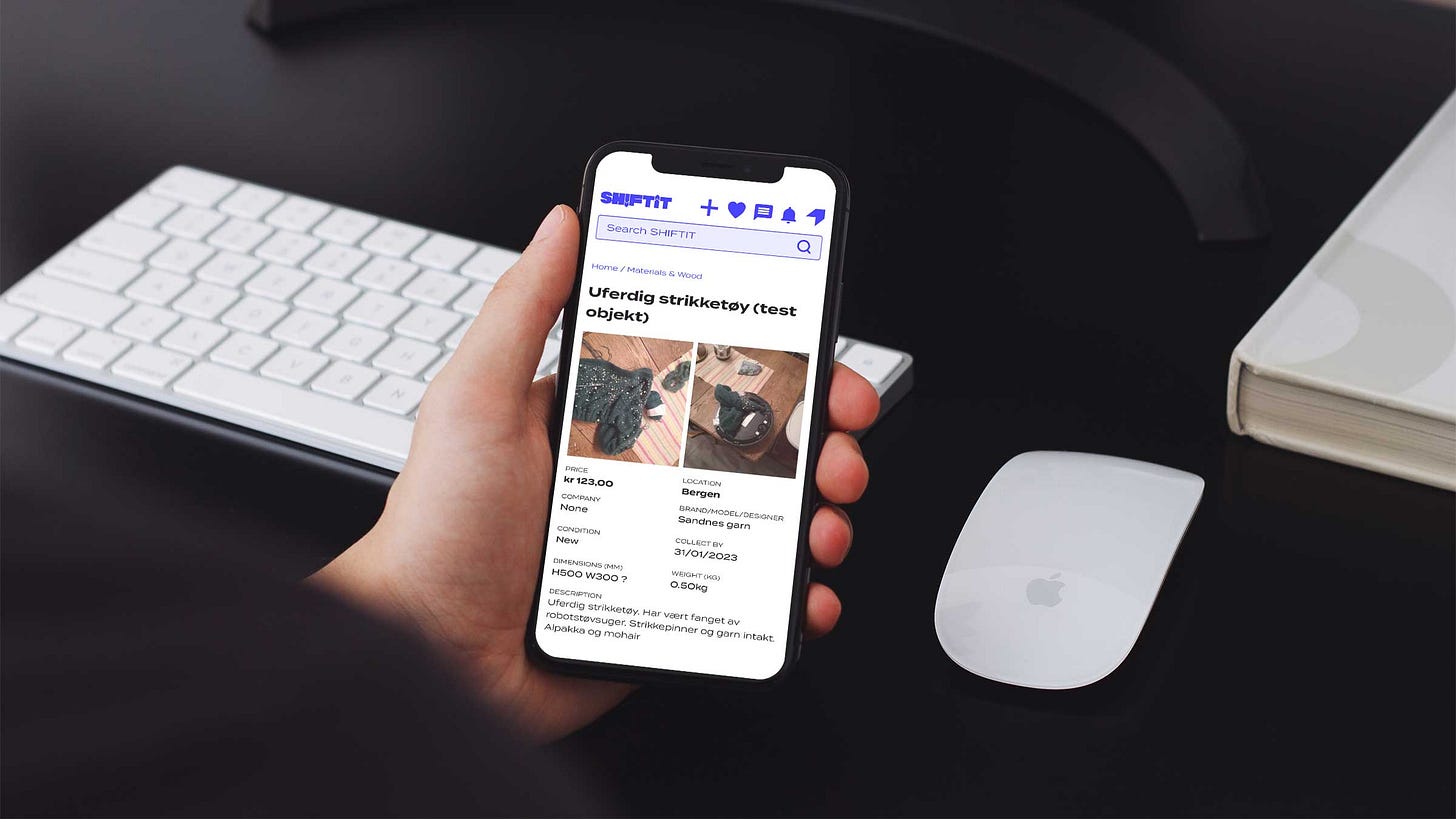Waste Not, Work Not: The Culture of Circularity
Why the arts and culture sector’s biggest waste isn’t money. It’s mindset.
Productions go up, final curtains drops. And almost everything goes straight to landfill.
This is the story of how Syv mil and I are helping break that cycle — and what happened when we did.
The arts and culture sector has a guilty secret: Most of its productions are rubbish.
Sorry — I mean most of them go to landfill, as rubbish.
Sets, costumes, props, print, plywood, signage, staging, graphics, entire theatres full of materials — designed, built, performed on... then scrapped.
Many wax lyrical about sustainability, yet rarely design for it.
SHIFTIT is our attempt to change that — to shift not just behaviours, but mindsets across an entire sector.
No pressure, then.
A Stage Exit, Not a System Exit
Circular economies are having a moment — from fashion to food, music and packaging to product design. But in the arts and cultural sectors, it's still treated as a backstage extra rather than a headline act.
This article explores what happens when you bring circularity to the forefront of cultural production — not as an afterthought, but as a creative principle. From Norway to the UK, we’re seeing glimpses of a new design logic: where reuse doesn’t limit creativity, it liberates it.
I work with the wonderful people at Syv mil — a Bergen-based collective of creative producers with deep roots in performing arts, literature, digital culture, and production — specialising in transforming bold cultural visions into reality. Working at the intersection of the artistic and the practical, Syv mil bring structure, strategy and long-term thinking to every stage of production. From festival programming to international touring, their team embeds sustainability and reuse into the DNA of cultural work.
SHIFTIT is Syv mil’s answer to their sectors guilty secret: waste.
Born from their deep commitment to sustainability and systems thinking, SHIFTIT challenges the norms of throwaway productions and proves that circular approaches don’t compromise creativity — they unlock it.
But this isn’t just about one company, or one country. This is about reimagining the systems we’ve built to celebrate creativity, without burying its leftovers in landfill.
The Theatre of Waste
Over 98% of UK theatre set materials go to landfill or incineration.
WRAP (2023), UK Theatre and Performing Arts Materials Report
📄 Download the PDF from WRAP’s official site
Behind every curtain call lies a pile of discarded plywood, vinyl, foamboard, acrylic, MDF, and cable ties. Theatre — and the wider world of cultural production — thrives on transformation. But too often, that transformation is brutally linear: build, perform, dismantle, discard.
We reward spectacle. We budget for impact. But rarely for reuse.
According to the UK’s Creative PEC and its 2023 report on theatre sustainability, most productions still rely on freshly sourced materials. Less than 2% of materials are reused across multiple productions — and even fewer are redistributed or recycled post-show. Over 98% end up incinerated or in landfill.
This isn’t because the creators don’t care. It’s because the system isn’t built to care. Budgets are rigid. Storage is scarce. And planning cycles are too short to prioritise reuse.
SHIFTIT challenges that by asking one simple question:
What if waste wasn’t the end — but the start of the next production?
Syv mil: Reimagining Reuse in Action
In 2022, Syv mil and I launched SHIFTIT with an online marketplace — specifically designed to encourage the arts and culture sector to adopt more sustainable practices. The platform allows organisations to redistribute, repurpose, and rehome materials that would otherwise go to waste. You can explore how it works here: https://www.shiftit.no/how-it-works.
What began as a digital platform has since evolved into a broader shift in creative production — where the process starts not with a mood board, but with a materials audit. Cataloguing existing stock from past shows, disassembled stages, and workshop scraps, Syv mil flipped the usual design model. Instead of designing then sourcing, they sourced then designed.
In theory, this flips the process. Instead of designing then sourcing, SHIFTIT encourages cultural producers to source thendesign — starting from what exists, not what’s imagined. In practice, this shift is still in motion. It’s less a polished loop and more a work-in-progress — nudging creatives toward new behaviours, one step at a time.
One noticeable result? A significant reduction in the need for new materials across multiple productions — simply by prioritising reuse and designing from what already existed. From foam-sculpted glaciers to pop-up festival entrances, Syv mil repurposed trusses, textiles, frames and stage flats to create bold new experiences with a fraction of the environmental cost.
And when a show ends? In some cases, it wasn’t sent to landfill. Some materials were logged, stored, and reallocated — often to community organisations or smaller cultural groups. But this behaviour is still the exception, not the norm.
And in Norway, that gap between ideal and reality may soon carry consequences.
Under the Transparency Act (Åpenhetsloven), which came into force on 1 July 2022, larger organisations — including many in the cultural sector — are legally required to conduct environmental and human rights due diligence across their supply chains. Annual sustainability statements are mandatory, and individuals have the right to request information on an organisation’s practices. Non-compliance can lead to substantial fines, with first-time violations already incurring penalties around NOK 450,000 (~€38,500).
The message is clear: circularity is no longer just a creative ideal. It’s becoming a compliance issue.
It’s a circular loop with creative freedom built in.
Circular Design for Creativity
Circularity isn’t just about saving money. It’s about making better work.
We’ve seen this across a range of creative sectors:
Mind the Gap Theatre in Yorkshire, England, has redesigned their touring sets to be modular, flat-packable, and easily shareable with partner venues across the North of England. Their production of Birdie used a reconfigurable structure that fits into a single van, reducing both material and transport emissions. Learn more.
RAM Galleri in Oslo has committed to eliminating the use of new plastics in its exhibitions. This artist-run space now prioritises reused materials, and in 2023, showcased a full exhibition built entirely from salvaged industrial waste. The gallery is part of the Norwegian Visual Artists (NBK) network. Visit RAM Galleri.
Green Man Festival in Wales operates a pioneering reuse system through its “Sustainable Stages” initiative. At the end of each festival, staging, signage, and set materials are sorted and offered to local theatre groups, community workshops, and schools. It’s part of a wider effort by organiser Fiona Stewart to make Green Man a leader in circular cultural production. See their sustainability efforts.
Each of these decisions adds friction — but also intention. It forces teams to question what’s really needed. What’s reusable. And what’s just there to fill space.
The result is leaner, smarter, and more emotionally resonant work.
Tariffs, Trends & The Bigger Picture

While circularity is deeply rooted in better ethics, it’s also increasingly shaped by economics.
Global trade is once again under strain. The 2024–25 US tariff war — reignited under King TACO Trump’s re-election — has driven up the cost of critical raw materials, including timber, aluminium, steel, and insulation products.
New tariffs on Chinese imports have had ripple effects across Europe, pushing up the price of construction materials and cultural infrastructure supplies. Reuters reports that these increases are already impacting manufacturing costs across the creative economy.
For cultural organisations already working with tight margins, this isn’t just another financial squeeze. It’s existential. Reuse isn’t a nice-to-have — it’s becoming a necessity.
Adopting circular design practices isn’t just the right thing to do — it’s a survival tactic. Reuse means resilience.
In this context, SHIFTIT is more than a project. It’s a playbook: a modular, open-ended framework for rethinking how the arts and culture sector budgets, plans, and manages their output — not just at the point of production, but from the first pre-production meeting to final curtain and beyond.
SHIFTIT embeds reuse into creative process, procurement, and even storytelling itself.
Work That Lasts Longer Than the Applause
SHIFTIT isn’t just about preventing waste — it’s about proving that circular creative work can still be radical, beautiful, and bold.
A second life doesn’t have to mean second-best. And an old stage flat can still carry new ideas.
We don’t need to sacrifice ambition for sustainability. We just need design ambition to last longer.
The Nice Bit After The Rant
Want to hear how Syv mil are applying SHIFTIT to RL productions? Or talk to us about adapting these methods to your organisations?
📩 Get in touch or join the SHIFTIT network: shiftit.no
📊 Explore the deck
📘 Read the full PEC report on UK Theatre










